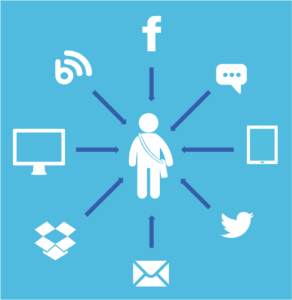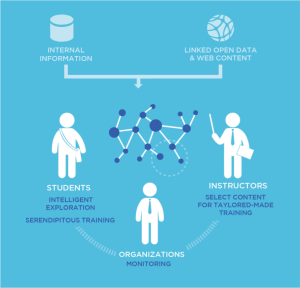Artificial Intelligence: a Catalyst in the Innovation of Learning and Development
Posted: November 7th, 2014 | Author: Domingo | Filed under: Artificial Intelligence, Conferences | Tags: 2014 IATA World People Symposium, AI, artificial intelligence, computational semantic, IATA, Innovation, John Naisbitt, knowledge map, learning & development, natural language processing, ontology, Taiger, test of Turing | Comments Off on Artificial Intelligence: a Catalyst in the Innovation of Learning and DevelopmentLast November 6th I had the chance of participating as speaker in the World People Symposium in Prague, a yearly event organized by IATA, the aim of which is to gather HR heads from several firms and organizations in the aviation industry to share best practices and become acquainted with the last trends regarding HR policies. I was invited as Taiger Marketing & Communications VP, in the workshop Innovation in Learning & Development, to explain how artificial intelligence translates source materials into personalized emotionally intelligent training.
Once again I would like to thank Jane Hoskisson and John Boggs from IATA for having given me the chance of exposing our futuristic approach regarding learning and training.
Here there is a summary of my speech:
“In 1982, the American researcher John Naisbitt stated the following in his book Megatrends: “We are drowning in information but starved for knowledge”. Since its inception in 2009 this thought has been the stimulus which has propelled Taiger.
Taiger is an international artificial intelligence company which, through its computational semantic and natural language processing abilities, helps firms transform information into knowledge and eases the communication between human beings and machines.
You may remember that scene of the film Blader Runner by Ridley Scott in which Deckard tries to know whether Rachel is a replicant or not through the Voight-Kampff test, a fictitious psychological test to find out if someone is a human being or a replicant, an android. Somehow this test was a pale echo of the well-known and completely scientific test of Turing: a test developed by the British mathematician and philosopher Alan Turing, the goal of which was to check out a machine’s ability to exhibit intelligent behavior equivalent to that of a human.
That’s futuristic scene, in which it was almost impossible to distinguish a replicant from a human being, is not so far away. In fact, in several sectors Taiger is striving to reach this level: particularly in the learning and training industry our firm has developed smart virtual instructors empowered by natural language processing abilities, which somehow may replicate human instructors’ activities.
Important: I’m not talking about hardware but software; that’s it, Taiger has not developed human-like robots, but e-learning platforms. Therefore and going back to movies again, we are still closer to 2001, a Space Odyssey with the supercomputer Hal9000 than to the replicants of Blader Runner; however, little by little we are approaching that final stage.
In Taiger we are deeply convinced the artificial intelligence is changing radically the learning and training processes. And this opinion is backed by the findings of several international research and reports, like the one of WISE.
WISE is the World Innovation Summit for Education: an initiative of Qatar Foundation that is an international platform for building the future of learning through innovation. The WISE community is a network, which gathers different stakeholders –students, instructors, learning centers, decision-makers…-, from around 200 countries, who share ideas to solve challenges facing learning.
According to this think tank:
1.- The technological revolution, being the Internet its main disruptive catalyst, will transform learning centers into “interactive environments”.
2.- The new learning culture will be based on principles of collective discovery, gamification, and innovation from bottom to up, and not on the traditional individualized learning from up –instructors- to bottom -students.
3.- Instructors will not only be knowledge transmitters but their main mission will be to guide students through their learning process. They will have to teach students to be critic and analyze the information they may encounter; and students will be encouraged to share knowledge and research.
Thanks to our project Saber y más with Grupo Santillana –probably the most important e-learning project developed in Spain for the past years, in Taiger we began foreseeing this scenario some time ago. It was then when our iLearning solution took its final shape.
Let me give you some details about this innovative cutting-edge learning project:
Grupo Santillana is the leading textbook publishing group in Spain, Central, and South America. When Santillana and Taiger got in contact it could be clearly realized that the learning and training industry was changing swiftly with the appearance of new players promoting massive open online courses (MOOCs), interactive content, gamification, and social media.
This was provoking a shift from the traditional closed learning interaction towards student-centric experiences delivered anywhere, anytime, in any format, and on any device. As market leader Grupo Santillana needed to stay on top of its game and continue shaping the learning industry.

Learning as a student-centric experience delivered anywhere, any time, in any format, on any device. Design by Lucila de Pasquale.
How did Taiger face this challenge? We put in value the learning resources developed by Santillana for the past 50 years, modeling the information stored in its database.
Through our computational semantic, natural language processing, and information retrieval capabilities we could develop an e-learning platform, based on a very complex ontology or knowledge map, with the goal of making available to students, instructors, and organizations hundreds of thousands of internal and external educational supplies.
What are the benefits of this e-learning platform? Amongst others:
1.- It has rendered students a new wider plethora of possibilities regarding how, what, when, and where to learn.
2.- It has enabled serendipitous learning and fluid bidirectional communication amongst stakeholders.
3.- It has allowed instructors to reuse, build, customize, and update training materials to fit the specific needs of the course, providing a solid alternative to the traditional manuals.
Maybe I used the wrong adjective in the beginning of my speech to talk about our learning approach: I said “futuristic”… But this is not futuristic anymore!
This is happening right now. With training platforms like the one we have developed, you can have access to knowledge from any device, from any channel, at any moment; you can have a 24/7 instructor, always ready to teach you new things, to provide you with all kind of likely exams, to give you always the right answer to your question, and even to be infinitely patient with slow learners like me!!!
Companies may benefit not only from the operational point of view, but also from the business point of view. Just imagine the following scenario: if part of your business revenues comes from your training activity, compulsory the business growth of this activity is defined and limited by the availability and capabilities of your training staff.
With these smart virtual instructors empowered by natural language processing abilities, you can multiply the reach of your offer without incurring in additional costs of recruiting and hiring new instructors.
These are mere scenarios. Possibilities are innumerable.
Future is here and it is up to us to take the most out of it.
Thanks very much for your attention.”
